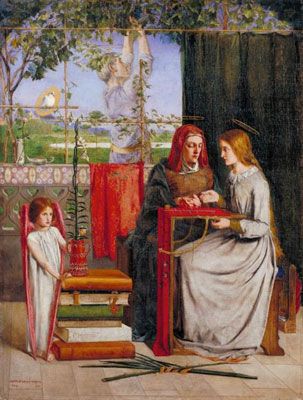The Girlhood of Mary Virgin (1848-9)
Artist: Dante Gabriel Rossetti
Artwork description & Analysis: This painting by Rossetti was the first Pre-Raphaelite work to appear in public. It featured the secretive initials "PRB," indicating that the artist was a member of the newly established Pre-Raphaelite Brotherhood. In the painting, the Virgin Mary appears at home with her mother, St. Anne, and an angel, while her father tends the garden outside the window.Share
The style is deliberately modeled on late Medieval and early Renaissance paintings, which were highly unpopular in Victorian England at the time. The composition defies the techniques of traditional perspective, with a notable flatness between the foreground and background, which foreshadows later artists' rejections of classical ways of depicting realistic space.
As art historian Jason Rosenfeld points out, "Rossetti's picture represents a revivalist style that draws on early Renaissance paintings from Northern Europe and Italy, blended with a comprehensive religious symbolism expressed in a profusion of clearly observed details and natural forms, such as the lilies redolent of the Virgin Mary's purity and the lamp evoking piety." Rossetti adds another touch of realism by portraying the likenesses of his mother and sister as Mary and Saint Anne; at the time this was considered blasphemous given the standard dependence on classical models for the Holy Family. Rossetti's daring combined with his Medievalist style was highly controversial and drew attention to the limits of the "Grand Manner" that was still celebrated in the British Academy. In effect, Rossetti was proposing a radical alternative way to represent even the most sacred of subjects. Oil on canvas - Tate, London (Read more.)


















No comments:
Post a Comment